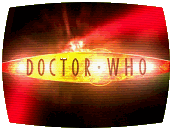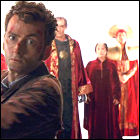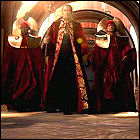 The Master has twisted the Immortality Gate into his own weapon, projecting himself as a template onto every human on Earth: every human on Earth is now the Master. The two aliens working undercover in Naismith’s operation are unaffected, and Wilfred is unaffected as well, stuck in the Master’s isolation booth. But the only other human not possessed by the Master is Donna Noble, whose adventures with the Doctor are flooding back into her mind. Wilfred urges her to run, but soon the amount of information crowding her human brain causes her to collapse. The Master interrogates the Doctor, demanding to know the whereabouts of the TARDIS, but this grueling interrogation is soon interrupted by the two aliens, who teleport themselves, the Doctor and Wilfred to their ship in orbit.
The Master has twisted the Immortality Gate into his own weapon, projecting himself as a template onto every human on Earth: every human on Earth is now the Master. The two aliens working undercover in Naismith’s operation are unaffected, and Wilfred is unaffected as well, stuck in the Master’s isolation booth. But the only other human not possessed by the Master is Donna Noble, whose adventures with the Doctor are flooding back into her mind. Wilfred urges her to run, but soon the amount of information crowding her human brain causes her to collapse. The Master interrogates the Doctor, demanding to know the whereabouts of the TARDIS, but this grueling interrogation is soon interrupted by the two aliens, who teleport themselves, the Doctor and Wilfred to their ship in orbit.
An alien artifact arrives on Earth, a piece of the extinct world of Gallifrey, and only then does the Master realize what the drumbeat in his head is: the rhythm of a Time Lord’s hearts. The Master uses this piece of Gallifrey to establish a link, and the entire planet of Gallifrey materializes close enough to Earth that tidal forces begin tearing the smaller planet apart. The Time Lords, desperate to escape their imminent doom in the Time War, have broken free by sending their distress signal – the drumbeat – back in time. They created the Master and made him a madman, all to compel him to provide an escape route for Gallifrey. The Lord President and members of the High Council of the Time Lords arrive on Earth, where the Master demands their obedience and just as quickly discovers that the Lord President is ready to eliminate him: the Master has served his purpose where the Time Lords are concerned. The Doctor cuts Gallifrey’s link to Earth as the Master and the Time Lord President do battle; the planet of the Time Lords disappears again, taking the Master with it.
But it is only after the crisis is averted that the Doctor realizes that the prophecy of his own death has nothing to do with the Time Lords or the Master.
written by Russell T. Davies
directed by Euros Lyn
music by Murray GoldCast: David Tennant (The Doctor), John Simm (The Master), Bernard Cribbins (Wilfred Mott), Timothy Dalton (Lord President), Catherine Tate (Donna Noble), Jacqueline King (Sylvia Noble), Billie Piper (Rose Tyler), Camille Coduri (Jackie Tyler), John Barrowman (Captain Jack Harkness), Freema Agyeman (Martha Smith-Jones), Noel Clarke (Mickey Smith), Elisabeth Sladen (Sarah Jane Smith), Jessica Hynes (Verity Newman), June Whitfield (Minnie Hooper), Claire Bloom (The Woman), Thomas Knight (Luke Smith), Russell Tovey (Midshipman Frame), David Harewood (Joshua Naismith), Tracy Ifeachor (Abigail Naismith), Lawry Lewin (Rossiter), Sinead Keenan (Addams), Joe Dixon (The Chancellor), Julie LeGrand (The Partisan), Brid Brennan (The Visionary), Karl Collins (Shaun Temple), Krystal Archer (Nerys), Lachele Carl (Trinity Wells), Paul Kasey (Ood Sigma), Ruari Mears (Elder Ood), Silas Carson (voice of Ood Sigma), Nicholas Briggs (voice of Judoon), Dan Starkey (Sontaran), Matt Smith (The Doctor)
LogBook entry & review by Earl Green
SPOILER WARNNG: this review discusses most of the major revelations of David Tennant’s final episode as the Doctor in considerable depth; if you haven’t seen this episode at least once, it’s probably best to save this review for later.
By turns both brilliant and banal, The End Of Time Part 2 is both a fond farewell to Russell T. Davies’ “era” of Doctor Who, and a series of textbook examples of why it’s probably best that the era in question is ending.
 What’s good about this episode: just about any scene where David Tennant and Bernard Cribbins have a one-on-one discussion. It’s a pity that we waited this late to team the two up; as much as we loved Cribbins is Wilfred Mott, Donna’s grandfather, getting to know him as something other than a one-off cameo or an ancillary character is great, and the rapport and respect between him and the Doctor instantly makes him one of the all-time great male TARDIS travelers, with loyalty which would rival that of Jamie McCrimmon himself. It’s a shame that Wilf didn’t board the TARDIS a lot sooner. Bernard Cribbins is able to milk many of his lines for a laugh, but it’s in scenes where he more dramatic instincts are dead-on that he truly soars.
What’s good about this episode: just about any scene where David Tennant and Bernard Cribbins have a one-on-one discussion. It’s a pity that we waited this late to team the two up; as much as we loved Cribbins is Wilfred Mott, Donna’s grandfather, getting to know him as something other than a one-off cameo or an ancillary character is great, and the rapport and respect between him and the Doctor instantly makes him one of the all-time great male TARDIS travelers, with loyalty which would rival that of Jamie McCrimmon himself. It’s a shame that Wilf didn’t board the TARDIS a lot sooner. Bernard Cribbins is able to milk many of his lines for a laugh, but it’s in scenes where he more dramatic instincts are dead-on that he truly soars.
The fact that the Doctor’s tenth life is sacrificed not to save the world, but simply to save Wilf, may well be the best part of the entire story. This really speaks to the heart of the Doctor’s character and to the message of the show overall: at one point, Wilf even tells the Doctor to go and leave him to his fate, and in a much colder analysis, no one would know if the Doctor did walk away – there would be no witnesses. That the Doctor does save him, at the expense of his own life (or one of them at any rate), having survived the whole epic dance of saving the world yet again, makes this the most personal and heart-wrenching regeneration story in the series’ history.
 The Time Lords prove to be one of the most fascinating classic series callbacks that the new show has given us. The state that they’re in – cowering and conferring in vast, dark chambers on a planet that’s clearly seen better days – says a lot about the devolution of the Doctor’s race. The Time Lord President, unable to allow for even the slightest disagreement, uses something that looks suspiciously like the resurrection gauntlet found by Torchwood (They Keep Killing Suzie) – or perhaps its opposite number – to deal with dissenters; one quickly gets that idea that his inner circle of advisors is routinely depopulated and repopulated. The Visionary, however, is perhaps the most telling element: a relic of a far more superstitious age, hearkening back to the New Adventures’ novels age of the Pythia’s rule of Gallifrey, she’s the Time Lord equivalent of setting war policy after consulting a psychic. The Time Lords are so utterly clueless at fighting or managing a war that they’re looking for clues in tea leaves and entrails.
The Time Lords prove to be one of the most fascinating classic series callbacks that the new show has given us. The state that they’re in – cowering and conferring in vast, dark chambers on a planet that’s clearly seen better days – says a lot about the devolution of the Doctor’s race. The Time Lord President, unable to allow for even the slightest disagreement, uses something that looks suspiciously like the resurrection gauntlet found by Torchwood (They Keep Killing Suzie) – or perhaps its opposite number – to deal with dissenters; one quickly gets that idea that his inner circle of advisors is routinely depopulated and repopulated. The Visionary, however, is perhaps the most telling element: a relic of a far more superstitious age, hearkening back to the New Adventures’ novels age of the Pythia’s rule of Gallifrey, she’s the Time Lord equivalent of setting war policy after consulting a psychic. The Time Lords are so utterly clueless at fighting or managing a war that they’re looking for clues in tea leaves and entrails.
The real jaw-dropper which comes late in the episode is that the Lord President may be Rassilon himself (which may explain why the Visionary is still around after delivering so much bad news – if she is a surviving Gallifreyan from the oft-vaguely-mentioned Dark Times, Rassilon might harbor his own superstitions about getting rid of her). Considering that Utopia and The Sound Of Drums established that the Master – who was presumed dead after falling into the Eye of Harmony in the eighth Doctor’s TARDIS – was somehow revived to serve as a last-ditch weapon in the Time War, it’s plausible that such a decision might have been taken by a people who were desperate enough for leadership that they would revive Rassilon as well. (In the Big Finish audios, Rassilon is still on the loose after the extended Divergent Universe cycle of eighth Doctor stories, so it’s also possible that Rassilon himself, in a regenerated form, could’ve seized on an opportunity to return to power and take charge of the Time War.) There’s also a metaphorical reading of the Rassilon reference: it could be that the President is just a President, and the Doctor is condemning all of corrupt Time Lord society by invoking Rassilon’s name, like someone blaming an entire population for its leader(s).
The other major piece of mythology dropped into our laps here is that the Master became the Master because of Time Lord interference. When this obviously encompasses every incarnation of the Master we’ve ever seen, this is a positively huge development. I’m on the fence, however, when it comes to explaining away/excusing all of the Master’s past transgressions, including numerous incidents of mass-murder, as symptoms of his victimization at the hands of Rassilon’s desperate cabal of hawkish Time Lords. in any case, John Simm again makes the most of his role, playing multiple versions of the Master again (including the frightening sight of the entire Chinese army as clones of the master).
Gallifrey being sent back into hell at the end of the episode probably isn’t a permanent change of address; if it hasn’t resurfaced in the next three years, it’ll allmost certainly figure into the nearly inevitable celebration of Doctor Who’s 50th anniversary in 2013, and you can bet the Master will return with it. If that doesn’t spell bad news requiring more than one incarnation of the Doctor, what does?
What doesn’t work here: the action scenes, while flashy and eye-popping, present ideas that just don’t stand up to much scrutiny. The Master launches an entire arsenal of nuclear missiles at the alien ship being piloted to Earth at kamikaze speed by the Doctor, while Wilfred and one of the aliens man Millennium-Falcon-style laser cannons to fend off the missiles. So… we’ve detonated dozens of nukes over the oceans of Earth with no ill effects? Similarly, and I thought this was nearly funny given that the collective memory of regeneration stories that have come before will be bubbling to the surface, we’re presented with the idea that the tenth Doctor can survive a parachute-less skydive, from a spacecraft moving at least at the speed of a jet plane, through a huge glass skylight dome and survive with what appears to be only moderate scratches and bruises and no broken bones… while a fall from a stationary radio telescope onto stationary grass from a lower altitude doomed the fourth Doctor? Sure, it all looked fantastic, a spectacular combination of visual effects and stunt work, but these things kept troubling me – a real case of style over substance.
At the end of the story, with the crisis abated, the Doctor manages to stave off his regeneration for a surprisingly long stretch, so he can go and see – and save – many of his old friends and companions one more time. These range from cute (Captain Jack in modern Who’s answer to the Star Wars cantina scene) to sobering (the Doctor saving Sarah Jane’s son Luke) to sweet (Donna’s wedding and a Rose return that I’ll actually let them skate by with) to real what-the-heck!? moments (a gun-toting Martha and Mickey, now married and “freelancing” against Sontarans?!?). In the middle of it all, the whole thing grinds to a halt for a callback to Human Nature / The Family Of Blood, and even though I’m an ardent fan of the series, it took a couple of moments for it to click with me that this was what the show was referring back to. It just seemed like an oddly obscure refrain, but still an effective one.
The regeneration itself is yet another spectacular event, possible indicating just how far the Doctor was pushing his own body to not change; the pent-up energy literally sets the TARDIS ablaze (though the real reason behind this was the desire of incoming producer Steven Moffat to revamp the TARDIS interior for Matt Smith‘s first season, as well as the production necessity to create a new TARDIS set that would stand up to high-definition scrutiny, something for which the Eccleston/Tennant TARDIS was never intended). Smith himself makes a promising (and funny) debut, getting more screen time in than I would’ve expected; the thought occurs to wonder how much influence Moffat had over Smith’s first words, as it seems a little odd to let Russell T. Davies establish the character.
Overall, The End Of Time Part 2 kisses off the Davies (and David Tennant) years in considerably flashy style, but also serves as a signpost that the show is in need of some new blood – this episode had a few eyebrow-raising moments, but nothing that was just actually jaw-droppingly bad. The change of management is happening while the show is still phenomenally popular, rather than waiting for the show to be in trouble. And if the recent stage-to-screen production of Hamlet is any indication, David Tennant won’t be suffering any of the typecasting problems that so many past Doctors have cited.
Bring on the Moffat and Smith years!

